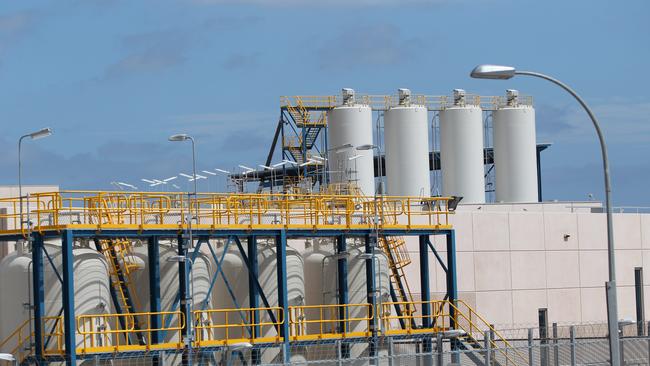Nuclear energy plan and desal plant for Upper Spencer Gulf key to growth, resources lobby says
SA must develop a plan for nuclear energy, the state’s chief resources lobby says, and should consider a second desal plant for the Upper Spencer Gulf.
A “nuclear energy road map” should be developed for South Australia, and the State Government should look at building a desalination plant and major water pipeline in the Upper Spencer Gulf, the state’s chief resources lobby says.
The South Australian Chamber of Mines and Energy says in its pre-Budget submission to the government that nuclear, as well as renewables, natural gas and hydrogen, should be on the table as a long-term energy source for the state.
The resources lobby group has submitted 11 key proposals to the State Government ahead of the June 22 Budget, including a call for a comprehensive energy policy including subsidies for gas exploration and policies and incentives to support carbon capture and storage.
SACOME chief executive Rebecca Knol said the resources sector believed there was still scope for a mature debate around nuclear energy, despite the issue having been raised – and dismissed – a number of times in the past two decades.

Most notably former premier Jay Weatherill’s Labor government in 2017 discarded any plans to get the state more involved in the nuclear fuel cycle after a citizen’s jury rejected support for the idea of a high nuclear waste repository in SA, which the then Liberal opposition also did not support.
The state’s former chief entrepreneur Jim Whalley, suggested late last year the state could double down on its natural advantages by embracing all aspects of the nuclear fuel cycle, including nuclear energy, however Energy and Mining Minister Dan van Holst Pellekaan said at the time there was no interest in getting involved in nuclear energy.
The Advertiser reported on Monday that a poll by the Liberal-aligned Menzies Research Centre indicated that at 63 per cent, SA had the highest level of support of any state for nuclear power.
Ms Knol said the state needed a comprehensive energy plan as the economy moved towards being carbon neutral over coming decades.
“We’re seeing the energy future as being one which needs to be agnostic about the energy type,’’ she said.
“If we are having meaningful conversations about net-zero by 2050, we need to be looking at all types of energy, not just at hydrogen or just renewables.’’

Ms Knol said for nuclear energy, and indeed for other technologies such as hydrogen, there was a lot of regulatory groundwork which needed to be laid before an industry could develop.
“I think the time is right for communities to have a conversation about nuclear. That obviously won’t be a nuclear power station in the terms that we think of it, it will be small, modular reactors.
“The technology for nuclear is changing. It’s probably not commercially available until about 2028, but even when it is commercially available, our regulatory settings won’t enable it to be utilised.’’
On the desalination front, Ms Knol said the plan would be to couple a desal plant with a high-capacity pipeline, which could meet the needs of the Department of Defence in the Woomera Prohibited Area, mining and energy companies in the state’s Far North, as well as other users.
“It’s quite an exciting project because it’s not just the resources sector which would be beneficiaries,’’ she said.
Ms Knol said the expansion of the state’s resources sector was dependent on access to a sustainable water supply, and there would be “huge environmental and community” benefits.
“It would be a game-changer if it went ahead,’’ she said.
Currently resources companies tend to rely on water from the Great Artesian Basin or other locally-available groundwater.
SACOME has also called for a “gas acceleration program” to promote the development of the state’s gas resources, making the Port Augusta to Whyalla route a dual carriageway, and a “critical minerals strategy” focused on minerals such as graphite, lithium, cobalt and others.

